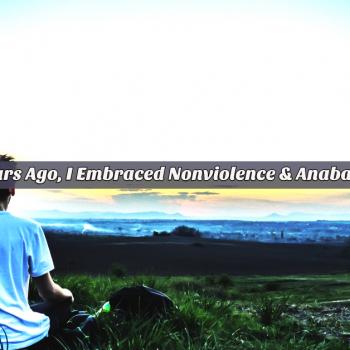The following is part of a fairly long series on the theology and practice of nonviolence. If you would like to read all of the posts, you can do so here.
————————————–
Throughout my life, I have been part of a unique culture. This is a group of people who can point to several common experiences and values. Not only so, but there is a common story that unites us all. This is a story of revival in the best sense of the word. One that led to several phases of religious and social persecution, for many, even to the point of death. My relatives, on both sides of the tree, can be traced back to this radical sect that chose to leave everything they had behind in order to search for a better way of life for their kin. Rather than taking a stand in the face of injustice by clenching to the sword, they chose to find their security in the nonviolent way of Jesus. When the persecution did not relent, many boarded ships headed toward the “new world.” It was during the late nineteenth century that my great grandfather arrived in the United States as a young boy.
Three generations later, I was born to wonderful parents who both could trace their roots back to the narrative of peace in the face of persecution. But, oddly enough, now about a century removed from arriving in America, the radical nature of my ancestors had begun to fade. My people are still quite bonded by a common culture, but something is quite different. I grew up with wonderful traditions, many of which centered on food and family. Every holiday we had zwieback, which is possibly the greatest bread that strawberry jam ever had the pleasure of pairing with. Often there would be other foods from the motherland such as bierocks and varenika. In our churches, I still get forced into playing the name-game, where based on my last name, older folks can tell me all about my family history and how they are my fifth double cousin twice removed. Our tradition is wonderful, but usually is experienced outside of the theological marks that originally set us apart.
The reality of my upbringing in this wonderful family of churches is that one key distinctive, which set us apart in the old land, is no longer part of our identity (at least as a whole). Finding comfort in a home that allowed us to exercise our faith in freedom, led to a love for this country. Over time, such a love led new generations into military service to defend the nation. By the time that I was growing up, nonviolence became that silly, unpractical belief that was more likely to be the butt of a joke than a central teaching of Jesus for the church. In a very real sense, I grew up as a Mennonite Brethren but not as an Anabaptist.
It was not until I was in my twenties that this seemingly outdated perspective on the discipleship way of Jesus began to draw me in. After spending all my life with the assumptions of a Southern Baptist (no offense to my Baptist friends), by conviction I have embraced my Anabaptist roots. In what follows is an exploration of the subject of nonviolence in the Bible, followed by some reflection on why many Christians dismiss it as folly.
Definitions
To begin this journey into the theology of nonviolence, it will serve us well to distinguish between terminology that is often used synonymously. Pacifism is the term that is most often employed to discuss the historical view of the Anabaptists, at least in common circles. The problem with this word is that it communicates the idea of inaction or withdrawal. Pacifism is often distorted to mean passivism. Another term that is used is nonresistance. A surface reading of Matthew 5.39 states, “do not resist an evil person.” Therefore, it is easy to see why nonresistance is a choice label. Traditionally, the Mennonite Brethren have preferred this term, but the New Testament does not seem fully against resisting someone if justice is threatened. For the next few posts, we will explore why I am uneasy with both of these common ways of describing Jesus’ teachings against violence. In order to do so, it is time to explore the relevant biblical texts (well, in the next post that is).
What have been your experiences with the subject of violence, just war, and nonviolence? I would love to hear your stories, even if you disagree with my perspective.

















